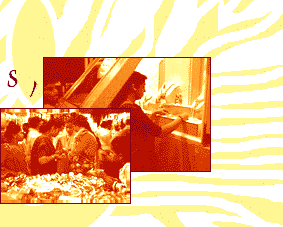


|
|

|
| HOME | TRAVEL | DIWALI SPECIALS | ||
 
|
|
TRAVELOG
TRAVEL DESK EVENTS AIRLINES SEARCH |
|
|
When the full moon of autumn rises on the eastern
horizon on Sharad Purnima day, Indians begin to relax
after nine hectic days of dandia raas dances and Ram Leela plays.
Both of which, last through the nine nights of Navaratri. We then
await the full moon of the Indian month of Ashwin -- when Goddess
Durga -- the vanquisher of the demons of hell, rests after the war
of nine days and nights with the demons of the underworld -- and
prepare for the festivities ahead.
With the moon resplendent in the cloudy autumn sky, the people of India begin preparing for the festival of Diwali. From this full moon to the new moon, is time for the greatest shopping gala of the year. Clothes, sweets, gifts, firecrackers and jewellery decorate shop windows, and hordes of shoppers fill the streets with noise and an almost electric energy. The first celebration of these riches -- brought home from the bazaar in cities and from farms and village markets in rural India -- marks the thirteenth day of the dark fortnight of Ashwin, Trayodashi. This is a day which precedes Diwali and is very aptly dedicated to wealth -- not necessarily material alone, but is also reminiscent of personal lustre, spiritual values and familial love. In colloquial parlance, Dhanatrayodashi is called Dhanteras and its twinkling lights set the mood of India's greatest and most popular festival -- Diwali, the festival of lights. Dhanteras is essentially Diwali eve. The day is usually spent by most families in finishing their shopping for the festival. By the time the satiated shoppers come home, it is time to light the first lamps of Diwali and to hang up paper lanterns with festoons which send out messages of love and goodwill to all. Dhanteras, being a festival of wealth, also means inaugurations and new purchases of expensive possessions. Many Indians set up their businesses, launch new projects, hold housewarming, set wedding dates, buy cars or jewellery on this auspicious day. Dhanteras evening is most exciting. While the lamps flicker in the darkness and the radiance of the flames removes the darkness of sorrow and past misdeeds, Lakshmi, the goddess of luster, beauty and wealth visits every home. Outside the threshold of every home, a rangoli, alpana or floor pattern is drawn with coloured powders or a nice paste and the stylised, tiny footprints of Lakshmi are drawn in vermilion to symbolise her arrival. Doors remain open and neighbours or communities get together to share sweets and tiny lamps. Lakshmi is such a popular deity among all Indians as the giver of plenty, the harbinger of health, wealth and happiness, that the woman of the house, or a newborn daughter is often called the Lakshmi of the home.
In bygone days, when silver was more readily available, traders celebrated Dhanteras by throwing silver coins in their work places and giving gold coins to their family members. Many families rode in Victorias or horse drawn carriages through the gold and silver markets to see the lights and the crowds gathered in narrow, busy streets. Here, gold and silver jewellers held a veritable mela or jamboree to welcome Lakshmi. No community worships this fickle goddess more passionately than jewellers and this is abundantly evident on Dhanteras day. Even in this age of super technology, gold markets still celebrate Dhanteras in the most gorgeous way, though the old horse carriages have been replaced by fast, sleek cars.
Dhanteras is not the actual Diwali day, but marks the beginning of the joyful Diwali celebrations. It is therefore the most
anxiously awaited day of the five day festival of Diwali. Dhanteras
is a good muhurat or auspicious time for buying gold, silver or
jewellery. Jewellers' shops remain open late into the night and
are crowded throughout the day.
|
|
|
HOME |NEWS |
BUSINESS |
SPORTS |
MOVIES |
CHAT |
INFOTECH |
TRAVEL
SHOPPING HOME | BOOK SHOP | MUSIC SHOP | HOTEL RESERVATIONS PERSONAL HOMEPAGES | FREE EMAIL | FEEDBACK |
|